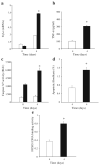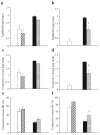Impaired wound healing in mouse models of diabetes is mediated by TNF-alpha dysregulation and associated with enhanced activation of forkhead box O1 (FOXO1)
- PMID: 19902175
- PMCID: PMC3130195
- DOI: 10.1007/s00125-009-1529-y
Impaired wound healing in mouse models of diabetes is mediated by TNF-alpha dysregulation and associated with enhanced activation of forkhead box O1 (FOXO1)
Abstract
Aims/hypothesis: The role of TNF-alpha in impaired wound healing in diabetes was examined by focusing on fibroblasts.
Methods: Small excisional wounds were created in the db/db mice model of type 2 diabetes and normoglycaemic littermates, and in a streptozotocin-induced type 1 diabetes mouse model and control mice. Fibroblast apoptosis was measured by the TUNEL assay, proliferation by detection of proliferating cell nuclear antigen, and forkhead box O1 (FOXO1) activity by DNA binding and nuclear translocation. TNF-alpha was specifically inhibited by pegsunercept.
Results: Diabetic wounds had increased TNF-alpha, fibroblast apoptosis, caspase-3/7 activity and activation of the pro-apoptotic transcription factor FOXO1, and decreased proliferating cell nuclear antigen positive fibroblasts (p < 0.05). TNF-alpha inhibition improved healing in the diabetic mice and increased fibroblast density. This may be explained by a decrease in fibroblast apoptosis and increased proliferation when TNF-alpha was blocked (p < 0.05). Although decreased fibroblast proliferation and enhanced FOXO1 activity were investigated in type 2 diabetes, they may also be implicated in type 1 diabetes. In vitro, TNF-alpha enhanced mRNA levels of gene sets related to apoptosis and Akt and p53 but not mitochondrial or cell-cycle pathways. FOXO1 small interfering RNA reduced gene sets that regulate apoptosis, Akt, mitochondrial and cell-cycle pathways. TNF-alpha also increased genes involved in inflammation, cytokine, Toll-like receptor and nuclear factor-kB pathways, which were significantly reduced by FOXO1 knockdown.
Conclusions/interpretation: These studies indicate that TNF-alpha dysregulation in diabetic wounds impairs healing, which may involve enhanced fibroblast apoptosis and decreased proliferation. In vitro, TNF-alpha induced gene sets through FOXO1 that regulate a number of pathways that could influence inflammation and apoptosis.
Figures





Comment in
-
Persistence of TNFalpha in diabetic wounds.Diabetologia. 2010 Jul;53(7):1537-8. doi: 10.1007/s00125-010-1766-0. Epub 2010 Apr 25. Diabetologia. 2010. PMID: 20419448 No abstract available.
Similar articles
-
TNF-alpha mediates diabetes-enhanced chondrocyte apoptosis during fracture healing and stimulates chondrocyte apoptosis through FOXO1.J Bone Miner Res. 2010 Jul;25(7):1604-15. doi: 10.1002/jbmr.59. J Bone Miner Res. 2010. PMID: 20200974 Free PMC article.
-
High levels of tumor necrosis factor-alpha contribute to accelerated loss of cartilage in diabetic fracture healing.Am J Pathol. 2009 Oct;175(4):1574-85. doi: 10.2353/ajpath.2009.090148. Epub 2009 Sep 10. Am J Pathol. 2009. PMID: 19745063 Free PMC article.
-
Dehydroabietic acid reverses TNF-α-induced the activation of FOXO1 and suppression of TGF-β1/Smad signaling in human adult dermal fibroblasts.Int J Clin Exp Pathol. 2014 Dec 1;7(12):8616-26. eCollection 2014. Int J Clin Exp Pathol. 2014. PMID: 25674226 Free PMC article.
-
Impact of Diabetes on the Protective Role of FOXO1 in Wound Healing.J Dent Res. 2015 Aug;94(8):1025-6. doi: 10.1177/0022034515586353. Epub 2015 May 15. J Dent Res. 2015. PMID: 25978971 Free PMC article. Review. No abstract available.
-
Brewing complications: the effect of acute ethanol exposure on wound healing.J Leukoc Biol. 2009 Nov;86(5):1125-34. doi: 10.1189/jlb.0209103. Epub 2009 Aug 12. J Leukoc Biol. 2009. PMID: 19675208 Free PMC article. Review.
Cited by
-
Phosphatidylinositol-3,4,5-triphosphate and cellular signaling: implications for obesity and diabetes.Cell Physiol Biochem. 2015;35(4):1253-75. doi: 10.1159/000373949. Epub 2015 Feb 11. Cell Physiol Biochem. 2015. PMID: 25721445 Free PMC article. Review.
-
11,12 Epoxyeicosatrienoic Acid Rescues Deteriorated Wound Healing in Diabetes.Int J Mol Sci. 2021 Oct 28;22(21):11664. doi: 10.3390/ijms222111664. Int J Mol Sci. 2021. PMID: 34769092 Free PMC article.
-
Foxo1 inhibits diabetic mucosal wound healing but enhances healing of normoglycemic wounds.Diabetes. 2015 Jan;64(1):243-56. doi: 10.2337/db14-0589. Epub 2014 Sep 3. Diabetes. 2015. PMID: 25187373 Free PMC article.
-
Glucose toxic effects on granulation tissue productive cells: the diabetics' impaired healing.Biomed Res Int. 2013;2013:256043. doi: 10.1155/2013/256043. Epub 2012 Dec 26. Biomed Res Int. 2013. PMID: 23484099 Free PMC article. Review.
-
PED/PEA-15 controls fibroblast motility and wound closure by ERK1/2-dependent mechanisms.J Cell Physiol. 2012 May;227(5):2106-16. doi: 10.1002/jcp.22944. J Cell Physiol. 2012. PMID: 21780113 Free PMC article.
References
-
- Lioupis C. Effects of diabetes mellitus on wound healing: an update. J Wound Care. 2005;14:84–86. - PubMed
-
- Claxton MJ, Armstrong DG, Boulton AJ. Healing the diabetic wound and keeping it healed: modalities for the early 21st century. Curr Diab Rep. 2002;2:510–518. - PubMed
-
- Singh N, Armstrong DG, Lipsky BA. Preventing foot ulcers in patients with diabetes. JAMA. 2005;293:217–228. - PubMed
-
- Falanga V. Wound healing and its impairment in the diabetic foot. Lancet. 2005;366:1736–1743. - PubMed
-
- Kane CD, Greenhalgh DG. Expression and localization of p53 and bcl-2 in healing wounds in diabetic and nondiabetic mice. Wound Repair Regen. 2000;8:45–58. - PubMed
Publication types
MeSH terms
Substances
Grants and funding
LinkOut - more resources
Full Text Sources
Other Literature Sources
Medical
Research Materials
Miscellaneous

